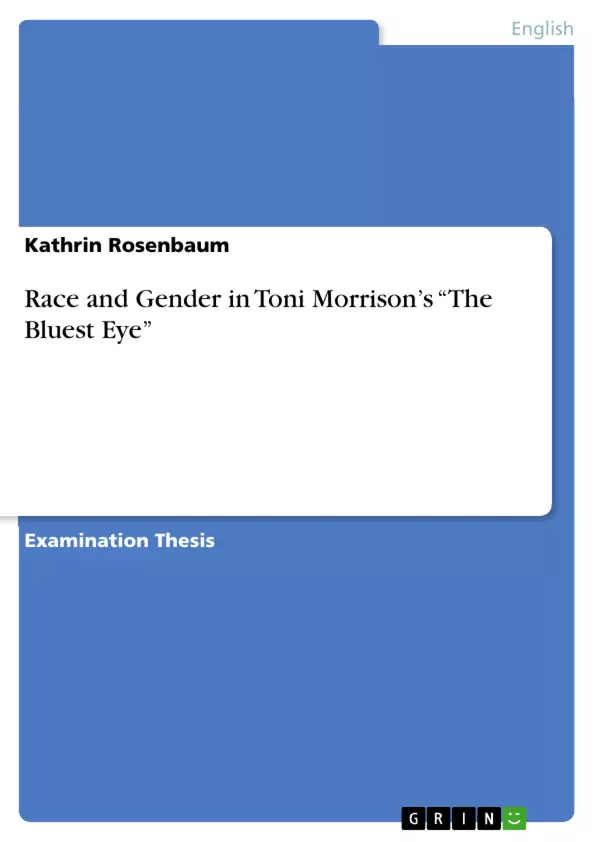Throughout history, the highly contested concepts of race and gender have adversely shaped the lives of millions of people. In the United States it is most notably Native Africans and African Americans who have been victimized on the grounds of their skin color. Women of African descent have suffered a double jeopardy due to the intersection of race and gender. For a great many of African Americans, men and women alike, literature has become an “important vehicle to represent the social context, to expose inequality, racism and social injustice.” In The Bluest Eye Toni Morrison explores the issue of African American female identity. The female Bildungsroman scrutinizes the problem of growing up black and female in a society which equates beauty with blue-eyed whiteness. Consumer goods, the media, adult approval and a dismissive attitude towards her mislead the protagonist Pecola Breedlove to internalize white beauty standards. With the story of Pecola, Morrison points out how the internalization leads to racial self-loathing and eventually to self-destruction. Nonetheless, the negative tone of The Bluest Eye is in part counteracted through Claudia MacTeer, whose narrative is juxtaposed to Pecola’s anti-Bildung and thus turns the novel into a double Bildungsroman with one girl “growing up” and the other one “growing down.”
The following thesis will focus on the issues of race and gender in The Bluest Eye. The topic can be considered of particular relevance as it addresses a theme which remained unexamined until the 1970s, a theme which many have not wanted to know about and which others have been in denial about. Morrison, though, faces the truth about the intersection of race and gender by exploring in her novel how racism and sexism function, as well as the devastating consequences that can occur. Her debut further underlines that the search for culprits is complicated since the perpetrators in the crimes against Pecola are often victims themselves.
[...]
Inhaltsverzeichnis (Table of Contents)
- Introduction
- Race and Gender in the African American Literature
- Socio-historical Context of The Bluest Eye
- Aesthetic Form of The Bluest Eye
- Racism in The Bluest Eye
- Anti-black Racism
- Internalized Racism
- Black Femininity
- Black Girlhood
- Black Womanhood
- Black Masculinity
- Black Femininity
- The Tragic Outcome
Zielsetzung und Themenschwerpunkte (Objectives and Key Themes)
This thesis analyzes the complex interplay of race and gender in Toni Morrison's "The Bluest Eye," exploring how these social constructs shaped the experiences of African American women in the United States. It aims to demonstrate the devastating consequences of internalized racism and how societal beauty standards contribute to self-destruction. The thesis also examines the unique perspectives of Black girlhood and womanhood, and the impact of racism on Black masculinity.
- The intersection of race and gender in African American literature
- The socio-historical context of "The Bluest Eye" and its influences
- The aesthetic form of the novel, including its unique structure and narrative techniques
- The various forms of racism, including anti-black racism and internalized racism, within the novel
- The tragic consequences of internalized racism and societal beauty standards on African American individuals
Zusammenfassung der Kapitel (Chapter Summaries)
The first chapter provides an overview of the concepts of race and gender in African American literature, establishing the context for Morrison's work. The second chapter explores the socio-historical context of the novel's setting, highlighting the cultural and political influences that shaped the story. The third chapter delves into the innovative aesthetic form of "The Bluest Eye," examining its unique structure and narrative techniques. The fourth chapter examines racism in its complexities, exploring both anti-black racism and internalized racism.
Schlüsselwörter (Keywords)
This thesis focuses on key themes and concepts such as race, gender, African American literature, Toni Morrison, "The Bluest Eye," internalized racism, beauty standards, Black girlhood, Black womanhood, Black masculinity, societal oppression, and psychological survival.
- Quote paper
- Kathrin Rosenbaum (Author), 2009, Race and Gender in Toni Morrison’s “The Bluest Eye”, Munich, GRIN Verlag, https://www.grin.com/document/310537



